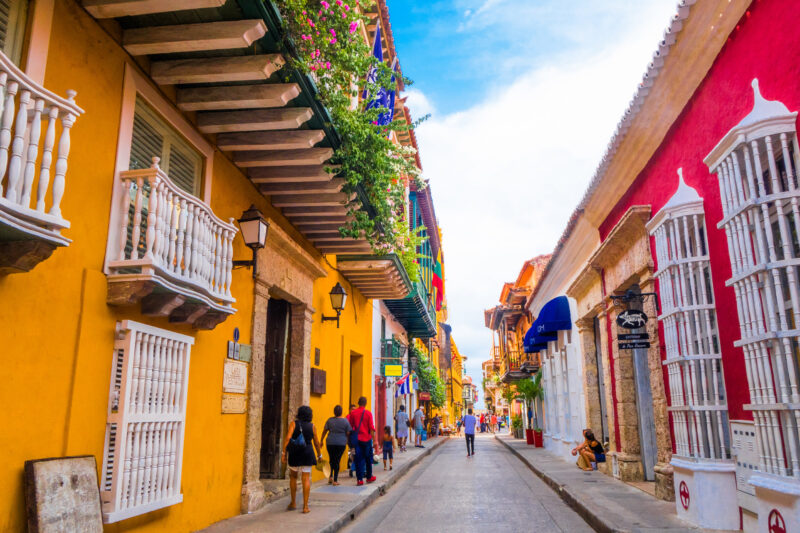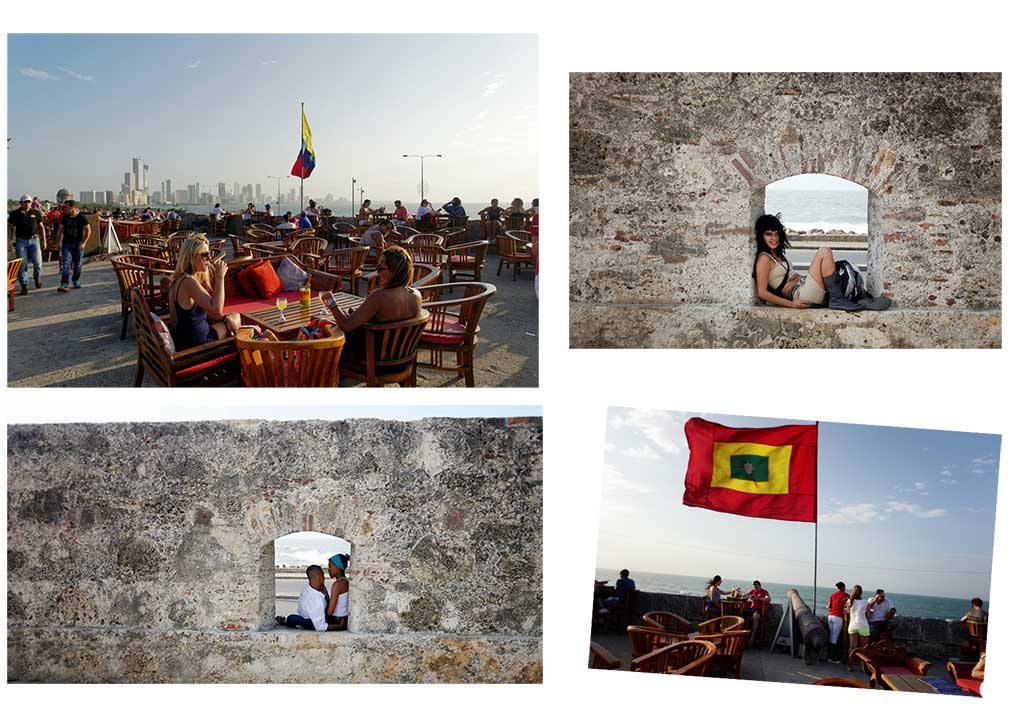
The Timeless Allure of Cartagena’s Walled City
Cartagena’s Old Walled City, or “Ciudad Amurallada,” remains one of Colombia’s most iconic destinations—a living museum with cobbled streets, colonial facades, and rich Afro-Caribbean culture. The historic heart of Cartagena continues to evolve without losing its soul, blending centuries-old architecture with high-end boutiques, fine dining, and stylish vacation rentals. Visitors are drawn here not only by the warmth of its tropical climate but also by its resilient energy—visible in every sunset-lit stone wall and vibrant courtyard. This UNESCO World Heritage Site, established in the 16th century as a fortress city to defend against pirates, is today a sanctuary of romance, history, and refined leisure. Whether you’re wandering past the flower-draped balconies of Getsemaní, savoring fresh ceviche in a candlelit plaza, or relaxing in a luxurious colonial-era rental home, Cartagena’s Walled City offers a truly immersive experience like no other in South America.
A Brief History of the Walls that Built a City
Cartagena’s Fortified Old City is the best-preserved colonial city in Latin America. The walled city was constructed in the sixteenth century by the Spanish conquistador Pedro de Heredia, named Cartagena de Indias after his birthplace in Spain. Located on Colombia’s Caribbean coast, the city quickly became a vital port for trade between Europe and South America, earning it the nickname “Queen of the Caribbean.” Cartagena is now Colombia’s fifth-largest city by population, after Bogotá, Medellín, Cali, and Barranquilla.
To protect its immense wealth—billions in gold, gems, sugar, and enslaved labor—flowing through its harbor, the Spanish Empire invested heavily in the city’s defenses. Cartagena’s fortified walls were constructed starting in 1586 after Sir Francis Drake’s infamous attack. Designed by Italian and Spanish military engineers, the thick coral-stone walls—some over 20 feet tall—were completed over a span of nearly 200 years. These fortifications encircle the Old Town, protecting it not only from pirates and privateers but also from coastal storms.
The defensive complex includes bastions, watchtowers, and gateways like the iconic Puerta del Reloj (Clock Tower Gate), which still serves as the principal entrance to the historic center. Today, the Old City Wall in Cartagena stands as a monument to that rough-and-tumble time when anxious lookouts scanned the horizon for enemy sails. It also remains one of the most complete and impressive examples of colonial military architecture in the Americas, bearing witness to Cartagena’s former status as a crown jewel of the Spanish Empire.

Cartagena’s Old City Wall Stats
Cartagena’s Old City Wall: Facts, Fortifications & Hidden History
Cartagena’s Old City Wall isn’t just a backdrop for vacation photos—it’s one of the most impressive and best-preserved examples of colonial military engineering in the Americas. Built to defend the wealth of the Spanish Empire from pirates and foreign navies, this sprawling fortification combines function with surprisingly elegant form.
- Total Length: The wall stretches approximately 11 kilometers (6.8 miles), encircling Cartagena’s historic center and harbor.
- Thickness & Strength: At its widest points, the wall is several meters thick—designed to absorb cannon fire and resist erosion from the sea.
- Material: Primarily built with coral stone quarried from the nearby coast, its texture and color give the wall its distinct weathered character.
- Architectural Detail: Graceful curves, vaulted arches, domed lookouts, and intricately joined stonework make the wall as beautiful as it is resilient.
- Construction Timeline: Work began in 1586 and continued in phases for over 200 years, evolving with new threats and technologies.
- Cost: The project consumed more than 20,000,000 Spanish reales—an astronomical sum at the time, reflecting the city’s strategic importance.
- UNESCO Status: In 1985, Cartagena’s Walled City and fortifications were designated a UNESCO World Heritage Site.
A defining feature of the wall are its bastions, or Baluartes—strategic bulges in the fortification that allowed defenders to position cannons and observe advancing ships from multiple angles. These structures served as both lookout posts and artillery platforms. One of the most iconic is Baluarte San Francisco Javier, which today doubles as a beloved local evening spot where visitors sip cocktails while watching the sun dip into the Caribbean Sea. It’s the perfect intersection of history and modern-day leisure.
Cartagena’s walls aren’t just relics—they’re a living part of the city’s rhythm, offering some of the best views, stories, and ambiance you’ll find in the entire Caribbean.

What to See and Do Inside the Old Walled City
From artisan markets to world-class art galleries, the Walled City is a dense mosaic of experiences. Visit Plaza Santo Domingo to admire the Botero sculpture and sip chilled rosé while street performers serenade your afternoon. Don’t miss Las Bóvedas, a former dungeon turned artisan shopping arcade for high-quality Colombian handicrafts. For culture lovers, Museo del Oro Zenú offers a fascinating look into the region’s indigenous history. Meanwhile, lovers of architecture can wander for hours admiring pastel-hued mansions and baroque churches like Iglesia de San Pedro Claver. Sunset walks on the wall are a must, with panoramic views of the Caribbean Sea and horse-drawn carriages clipping past below.
Want to stay in the heart of it all? Browse our curated collection of luxury Cartagena property rentals inside the Walled City for an unforgettable stay.
Where to Eat, Drink & Soak in the Atmosphere within the Walls
Dining in Cartagena’s Walled City is more than just eating—it’s a full-sensory experience rooted in heritage, seasonality, and modern creativity. Begin your morning at Café Época Espresso Bar, a local favorite that pairs expertly pulled espresso with chic interiors and an elevated brunch menu. For lunch, explore smaller chef-owned spots tucked within restored colonial buildings, where menus highlight Caribbean ingredients like coconut rice, fresh snapper, and tropical fruits. In the evening, Carmen Cartagena continues to lead with its elegant tasting menus and focus on local sourcing, while Celele in nearby Getsemaní push culinary boundaries with indigenous techniques and ingredients. Don’t miss an aperitif on one of the city’s lesser-known rooftops like Alquímico’s third floor, where mixology meets Cartagena’s sultry skyline. For a curated list of the city’s top dining and drinking experiences—well beyond the tourist trail—explore our full eating and drinking guide.
Visiting the Old City Wall Today
From atop the massive stone structure visitors can stare out over the Caribbean Sea and bask in the tropical sun. During the day the Old City Wall makes for an incredibly scenic backdrop and a historically education trip for the kids. The Old City Wall is even wheelchair accessible in certain places. However, it does take about 2 hours to walk leisurely along its entire length so be sure to avoid the hottest parts of the day.
As the sun goes down the Old City Wall becomes incredibly romantic. The daytime heat ebbs to a cozy sort of warmth and the tropical sun bathes the Caribbean Sea in a wash of color. Take a stroll with that special someone or stop at Baluarte (a bar on top of the wall) offers fresh cocktails and an unbelievable view.
During high season or various festivals throughout the year, the wall and the bastions along it come alive with performance artists and buskers providing live music, traditional dance, and even visual art exhibitions.
Come for the romance or the history and Cartagena’s Old City Wall won’t disappoint.

